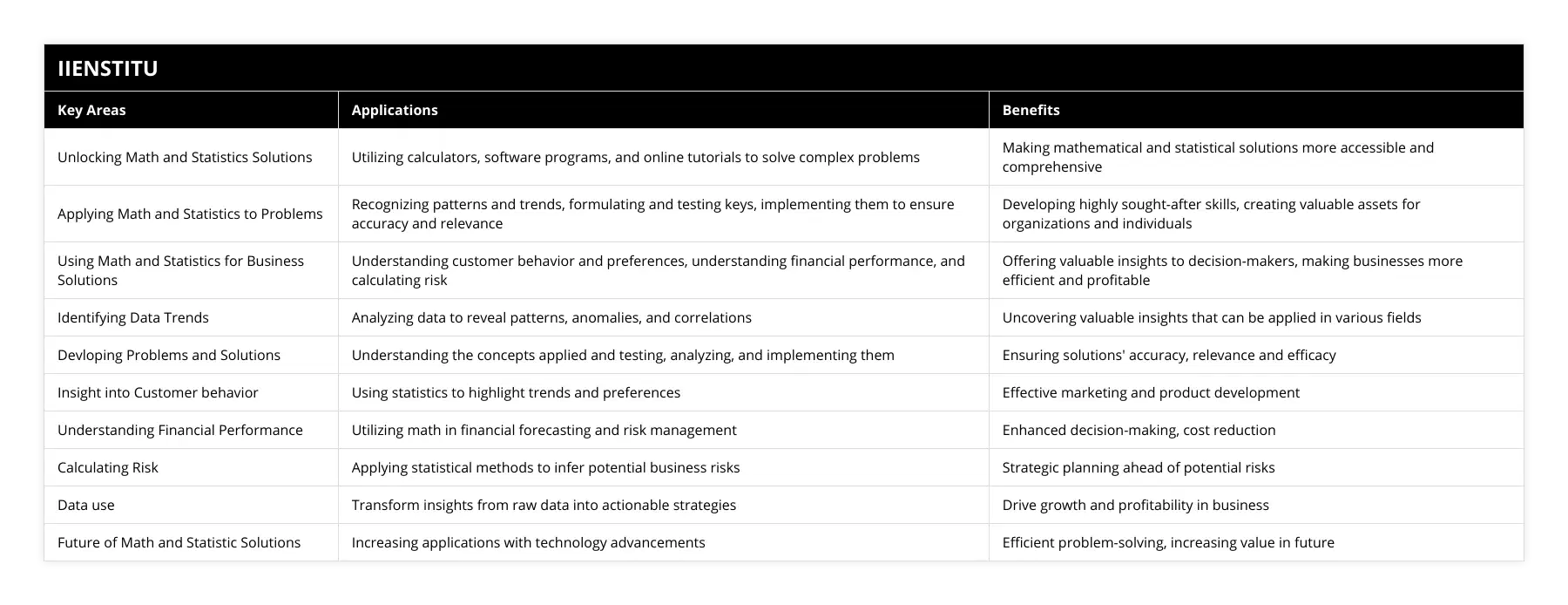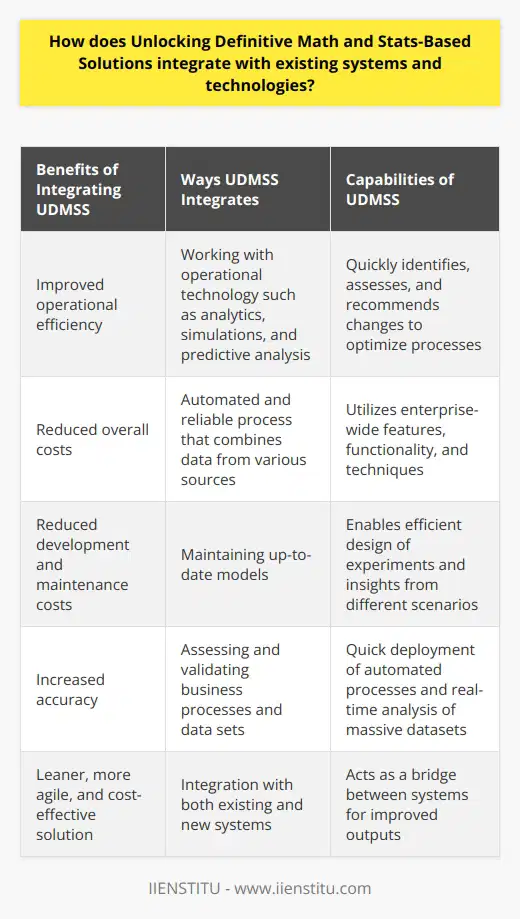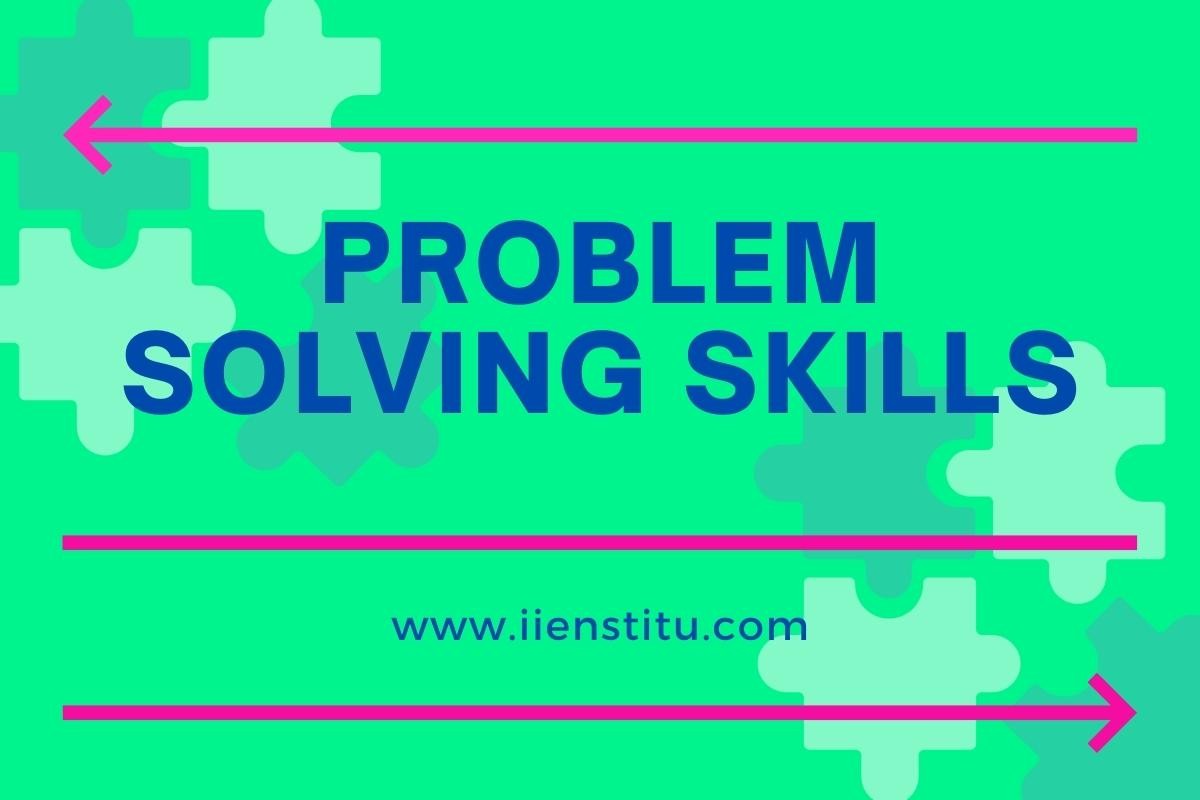
Unlocking Math and Statistics Solutions
Applying Math and Statistics to Problems
Using Math and Statistics for Business Solutions
Math and statistics are powerful tools that provide insight into the problems we face in our everyday lives. Math and statistics-based solutions have become increasingly important in our technologically driven world, allowing us to draw on data to create more effective solutions. In this blog post, we will explore the scope, benefits, and significance of math and statistics-based solutions and how to unlock the power of math and statistics to create solutions for any problem.
Unlocking Math and Statistics Solutions
Math and statistics are highly analytical disciplines that often require much calculation and algorithmic thought. Thankfully, various tools and resources can help unlock the power of math and statistics and make these solutions more accessible. These tools and resources can range from calculators to software programs and even online tutorials that provide detailed guidance when tackling more intense problems.
In addition to resources, it is essential to understand the strategies used to recognize patterns and trends. These strategies vary depending on the data set and its characteristics. Still, the idea is to identify data trends, anomalies, and correlations that can provide valuable insight. Analyzing data is a handy skill that can be applied in almost any field and with any problem.
Applying Math and Statistics to Problems
Once data has been analyzed, and insight gained, it is time to develop problems and solutions. To do this effectively, it is essential to understand the mathematical and statistical concepts being applied to unique situations. Once the keys have been formulated, testing, analyzing, and implementing them is necessary to ensure accuracy, relevance, and efficacy. Devising and developing solutions to problems is a highly sought-after skill. It can be a precious asset to any organization or individual.
Practical Techniques İn Descriptive Statistics For Data Analysis
Root Cause İdentification Techniques For Effective Decision Making
Using Math and Statistics for Business Solutions
Regarding business solutions, math and statistics can offer many benefits. From providing more insight into customer behavior and preferences to understanding financial performance and calculating risk, math, and statistics can provide valuable information to business owners and decision-makers. Along with providing valuable insight, it is also essential to be able to use this data in a meaningful way. Companies such as Google and Microsoft have successfully used math and statistics to develop solutions that have made their businesses more efficient and profitable.
JIT (Just-in-Time): A Comprehensive Examination of its Strategic Impact
Root Cause Tree Analysis: Insights to Forensic Decision Making
Hazard Analysis: A Comprehensive Approach for Risk Evaluation
In conclusion, math and statistics are powerful tools that can be employed to develop virtually any solution. By unlocking the power of math and statistics, problems can be better understood, and answers can be created. The value and importance of math and statistics-based solutions will increase as technology advances. With access to the right resources and a strong understanding of math and statistics, businesses and individuals can solve any problem.
Knowledge of mathematics and statistics opens the door to powerful insights and solutions.

Frequently Asked Questions
What strategies does Unlocking Definitive Math and Stats-Based Solutions provide for improving decision-making processes?
Decision-making is a critical component of any successful business. They are unlocking Definitive Math. Stats-based Solutions (UDMS) has developed strategies to improve the processes involved. These strategies include incorporating data-driven decision-making, utilizing analytics and optimization capabilities, and creating an environment that encourages creative problem-solving and collaboration.
Data-driven decision-making involves collecting and leveraging data to inform decision-making processes. UDMS employs an iterative approach that begins with a clear understanding of stakeholders’ needs, followed by the collection and analysis of data, and finally, a strategic execution of plans and executions. To maximize returns, the data must be timely and accurately collected, analyzed, and shared in formats that colleagues and stakeholders can understand. This approach maximizes the use of data and can reduce uncertainty when making decisions.
UDMS also uses analytics and optimization capabilities to ensure that the data collected is used for forecasting and informing decision-making processes. Data-driven analytics can provide insights into trends, anomalies, and customer preferences. Optimization capabilities can be used to identify optimal solutions based on criteria. By leveraging analytics and optimization capabilities, decisions can be better informed and more tailored to stakeholders’ needs.
In addition to data-driven decision-making and analytics and optimization capabilities, UDMS fosters an environment that enables creativity and facilitates collaboration between stakeholders. UDMS can capitalize on ideas from different perspectives and creative solutions by providing stakeholders with an atmosphere that encourages problem-solving. Through collaboration, collaborative decision-making processes become more effective, resulting in better decisions that can yield higher returns.
In conclusion, Unlocking Definitive Math and Stats-Based Solutions provides strategies to improve decision-making processes. These strategies involve data-driven decision-making, analytics, and optimization capabilities and fostering an environment that encourages creativity and collaboration. By using these strategies, companies can create better decisions and maximize returns.

How does Unlocking Definitive Math and Stats-Based Solutions integrate with existing systems and technologies?
Unlocking Definitive Math and Stats-Based Solutions (UDMSS) offers an efficient way to integrate with existing systems and technologies because it can rapidly identify, assess, and recommend changes to optimize processes. This integration ensures reliability by leveraging enterprise-wide features, functionality, and techniques while improving operational efficiency and reducing overall costs in the long term.
UDMSS can work with operational technology such as analytics, simulations, and predictive analysis to identify process flaws, revenue leakage opportunities, and cost savings. UDMSS integrates with existing systems to provide an automated, reliable process that combines data from multiple sources and analyses it to produce meaningful insights. This lets companies make well-informed operations, service delivery, and financial management decisions.
The integration of UDMSS also reduces development and maintenance costs for existing systems by ensuring that models remain up-to-date. In addition, UDMSS allows users to efficiently design experiments and gain insights from different business scenarios. The models can then be optimized and quickly ported to the existing system. This enables processes to be streamlined and automated due to the breadth of data being handled and the broad range of applications.
The integration of UDMSS can be applied not only to existing systems and technologies but to new implementations too. UDMSS can quickly assess and validate any business process and data set and increase accuracy. This provides a much faster way to deploy automated processes than traditional methods. It also can be used to analyze massive datasets of complex information such as customers, prices, and inventory in real-time.
The wide range of UDMSS capabilities facilitates its integrations with existing systems and technologies. It enables faster, more efficient decision-making and reduces implementation and maintenance costs. UDMSS can act as a bridge between existing systems to create an efficient and reliable process for improved outputs. This results in a leaner, more agile, and cost-effective business solution.

What examples of practical applications have been successfully implemented using Unlocking Definitive Math and Stats-Based Solutions?
In recent years, Unlocking Definitive Math and Stats-Based Solutions (UDMSS) have become increasingly common tools to solve complex problems. UDMSS involves the application of mathematical and statistical models to provide evidence-based solutions to specific challenges. Because of the wide range of methods and techniques they employ, UDMSS has a variety of applications in the business, engineering, and scientific sectors. In this article, we will explore several examples of practical applications of UDMSS that have been successfully implemented.
One example of how UDMSS can be used in practice is forecasting. Businesses and organizations can use UDMSS to predict the potential performance of products, services, and strategies. By leveraging large datasets and sophisticated modeling techniques, these algorithms can provide highly accurate predictions about future performance. This can give businesses a competitive edge in their industries, as it can help them identify and capitalize on the best opportunities for success.
In the engineering and scientific sectors, UDMSS has been used to improve various technology applications. For example, UDMSS algorithms have been used to develop self-driving cars and improve facial recognition algorithms' accuracy. In addition, engineers and scientists have created highly accurate and efficient autonomous technology by leveraging large datasets and sophisticated models.
Finally, UDMSS has become invaluable in the healthcare industry. By leveraging the power of predictive analytics, medical professionals can use UDMSS to personalize treatments and therapies for each patient. As a result, UDMSS algorithms can be used to determine the best course of action for a given patient, thereby reducing costs and improving outcomes. In addition, these algorithms can be used to identify potential health risks and develop new treatments and therapies.
In conclusion, examples of practical applications of Unlocking Definitive Math and Stats-Based Solutions (UDMSS) have been successfully implemented across various industries. These algorithms have enabled businesses to gain a competitive edge by providing accurate predictions about future performance. They have also enabled engineers and scientists to develop precise, highly autonomous technology. For example, predictive analytics has enabled medical professionals to personalize treatments and therapies for each patient in the healthcare sector. As UDMSS advances, there is no doubt it will continue to be used successfully to overcome a wide range of challenges.



